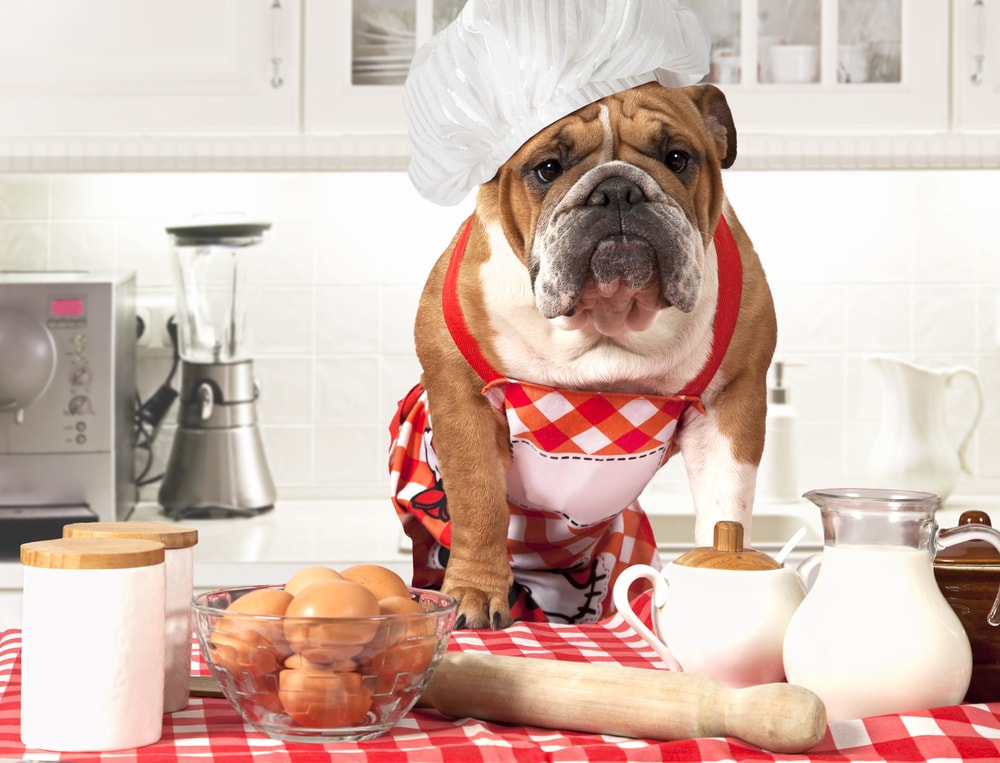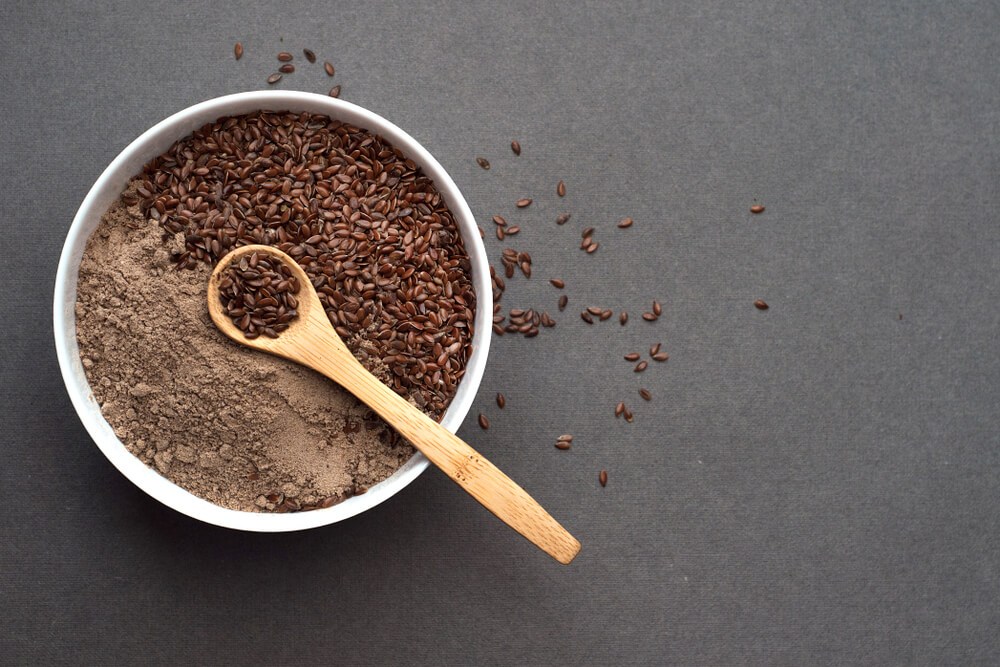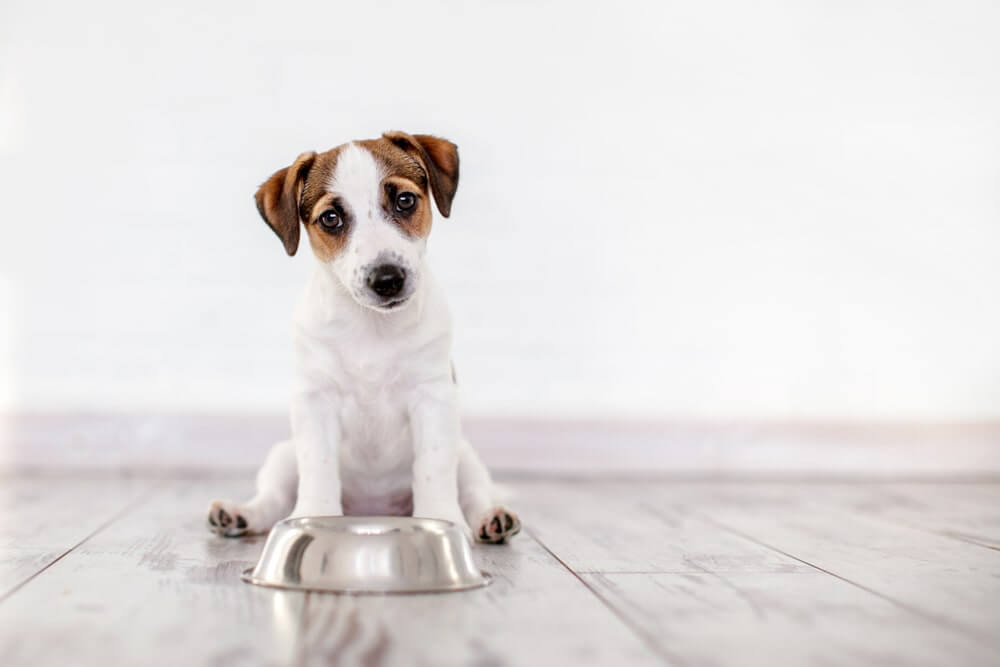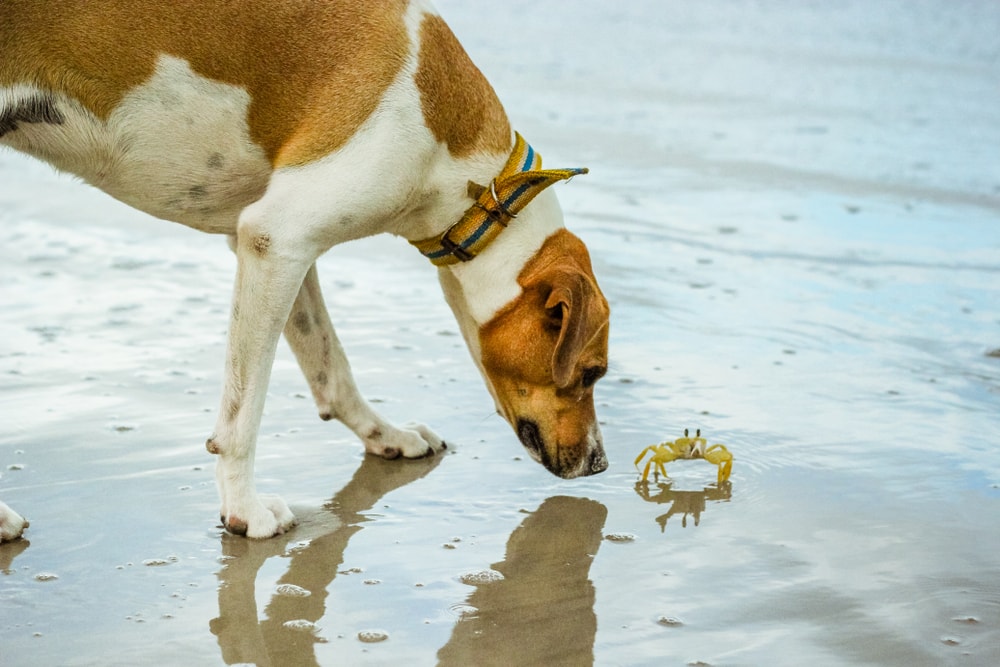Hey Ollie blog readers! We’re offering you an exclusive 60% OFF your starter box! Try now!
To ensure your prized pup is receiving wholesome nutrients that come from recognizable ingredients, rather than the unpronounceable preservatives and additives found in many off-the-shelf dog foods, you may consider making dog food at home. Doing so is a good idea, because bag-to-bowl dog foods can include filler ingredients, such as corn, wheat, and soy, which add calories but little nutritional value.
Although these brand-name morsels might make your pup beg for more, they aren’t necessarily the most nutritious. Gary Weitzman, DVM, President of the San Diego Humane Society and author of the book The Complete Guide to Pet Health, Behavior, and Happiness, poses this analogy: “I like hotdogs, but I’m not going to live my whole life eating them.” Before you embark on a do-it-yourself (DIY) dog food cooking journey, you must understand the benefits and risks of making your own dog food.
In this guide, we’ll break down how to make homemade dog food safely, the real risks to watch for, and smart ways to keep your pup’s meals balanced and vet-approved.
What Is Homemade Dog Food?
Homemade dog food means you prepare your dog’s meals yourself using fresh, whole ingredients, instead of buying store-bought kibble or canned food. Some dog parents cook full meals from scratch with ingredients like lean meats, cooked grains, and vegetables. Others use home cooking to supplement a high-quality commercial diet with fresh toppers.
The goal of homemade dog food is simple: to know exactly what’s in your dog’s bowl. No hidden fillers, artificial flavors, or mystery by-products, just real food you’d feel good serving your family.
But “homemade” doesn’t automatically mean “balanced.” Dogs have different nutritional needs than humans. They need the right mix of protein, fat, fiber, vitamins, and minerals to stay healthy. Even with the best intentions, many DIY recipes miss important nutrients like calcium, omega-3s, or certain vitamins.
According to the American Kennel Club (AKC), If you choose to prepare meals for your dog at home, it’s critical to ensure they’re nutritionally complete and balanced. That’s why many pet parents who try homemade dog food work closely with a vet or a board-certified veterinary nutritionist.
Done right, homemade dog food can be healthy and delicious for your pup, but it takes careful planning, safe food handling, and the right recipes.
Benefits of Homemade Dog Food
Home cooking is comfort food in more ways than one, because making your own dog food can provide you with the confidence and peace-of-mind that you can’t attain from purchasing food off the shelf. Here are the top benefits of homemade dog food:
No Need to Worry About Pet Food Recalls
Well- and lesser-known brand dog foods can be recalled for many reasons. Common recall causes include package mislabeling, insufficient or excessive vitamins and minerals, unsafe shipping or handling, and quality control issues, such as mold or bacterial contamination, some of which may cause foodborne illness.
Control Over Ingredients
Every dog is unique, and their food should be too. Unfortunately, commercial dog food diets cannot be customized. You can enhance this straight-from-the-shelf food by adding toppings to boost the flavor, caloric content, and nutritional value, however, you cannot remove an ingredient your pet is unable to tolerate, or substitute one food for another. With commercial dog foods, you must select an entirely different recipe or formula if your pooch needs one that better suits their needs.
Control Over Preparation and Storage
Quality control is literally in your hands when you cook your own dog food. From ingredient sourcing to cooking in your own kitchen, you can control all food-safety aspects and ensure that every ingredient your dog eats is washed, cooked and stored correctly.
Cook in Batches and Freeze
Commercial dog food diets are touted for their convenience, but with meal prepping, homemade dog foods are equally easy to assemble and preserve. When you cook a large batch, you can freeze the food in meal-size portions, which helps ensure you have as much food as your pet needs. Simply thaw and serve!
Potential Risks of Homemade Dog Food
Although homemade food seems to be the right choice for pup health, some risks are associated with DIY dog food. Consider these drawbacks to cooking your dog’s food at home:
Nutrient imbalance and deficiency
In a University of California, Davis, School of Veterinary Medicine study (UC Davis), 200 popular homemade dog food recipes were reviewed for completeness and nutrient balance. UC Davis researchers found that most of the recipes, including some veterinarian-designed formulas, lacked essential nutrients, which could lead to serious future health issues.
In Weitzman’s book, which we discussed earlier in this article, some of the most common DIY dog food recipe miscalculations include inappropriate calcium levels and insufficient taurine, an amino acid often found in organ meats. Persistent taurine deficiency can lead to a dog experiencing serious cardiac problems, including an enlarged heart.
To provide a nutritionally balanced homemade food for your dog, ask your veterinarian to recommend an appropriate and nutritious recipe. In addition, confirm that a board-certified veterinary nutritionist has approved the recipe.
Harmful ingredients
Another common DIY dog food problem is inadvertently adding toxic ingredients to your pup’s plate. Never include granulated, powdered, or whole-food garlic, onions, macadamia nuts, avocados, grapes, or raisins to your dog’s food.
When is a Home Cooked Meal Right For Your Pup?
Short-term home cooking for pets can be beneficial, although long-term nutritional risks may outweigh the benefits.
Consider making your dog’s food in these situations:
Your Pup is Sick
If your dog is sick, especially with gastrointestinal (GI) issues, providing them with a home-cooked bland diet for a few days may be part of your veterinarian’s recommended treatment plan. Skinless boiled chicken, lean ground beef, or plain scrambled eggs with rice can enhance your pet’s appetite and soothe their upset stomach. Ask your veterinarian which ingredients are suitable for your dog’s condition, and expect to see an improvement in a few days. Check in with your veterinarian before returning your pup to their normal diet.
What’s the Best Food for Your Dog’s Digestive Health?
Your Pup is Recovering from Surgery or Their Appetite Has Decreased
High-quality nutrition is key to your pet’s illness or surgical recovery, but under these circumstances, dogs often struggle to maintain their interest in food. Home cooking aromas and flavors can awaken your pup’s palate and enhance their appetite. Ask your veterinarian if healthy enticements, such as bone broth with chicken and carrots, roasted sweet potatoes, or grilled fish, are appropriate options for your convalescing canine.
Your Pup’s Food is Unavailable
If you don’t have your pup’s normal fresh or raw food diet on hand because of a delayed or damaged shipment or travel, or you’ve simply run out, home-cooked meals can fill the gap and your pup’s stomach. To prevent GI upset, use your dog’s current food as an ingredient guide, such as including chicken, rice, spinach, and blueberries if these are in their regular commercial food. While you may not get the same precise vitamin and mineral balance, the homemade food will be less likely to upset your dog’s stomach or compromise their nutritional needs.
Common DIY Dog Food Cooking Mistakes
Cooking your dog’s food is more than simply combining healthy ingredients. Dogs have unique species-specific nutritional needs, which are extremely different from those of humans. According to Richard Hill, DVM, Associate Professor at the University of Florida College of Veterinary Medicine, Gainesville, these needs include specific amounts of essential nutrients, proteins, essential fats, vitamins, and minerals—an impressive and difficult feat to achieve in a home kitchen.
Consider some common miscalculations veterinary nutritionists advise you to avoid when preparing DIY dog food:
Nutritionally Imbalanced Recipes
Not only do dogs require specific nutrients, but the substances must be included in specific ratios. For example, in addition to creating the right mix of protein, carbs and fats, you must ensure the recipe’s calcium-phosphorus ratio is one-to-one. Vegans will be disappointed to learn that Greg Aldrich, PhD, Pet Food Program Coordinator at Kansas State University, Manhattan, recommends feeding your dog real meat, because they need animal-based protein to ensure they receive essential amino acids, vitamins, and minerals. Whenever possible, your dog’s essential nutrients should come from whole-food sources, not supplements, to ensure maximum bioavailability.
Ingredients Lack Essential Nutrients
DIY dog food preppers most commonly leave out critical nutrients such as calcium and phosphorus. However, you can add these essentials by incorporating finely ground bone, bone meal, ground eggshells, or commercial supplements into your dog’s food. Fiber is also frequently overlooked, which according to Aldrich, is a serious problem. If you only feed your dog protein, fat, and vegetables, they will be able to digest everything, but will be unable to eliminate it, which will cause your pooch to become ill, he explains.
Protein is Too Fatty
For health reasons, humans prefer the leanest meat cuts, but dogs need their meat to have between a 15% and 20% fat content. If you’re using high-fat oils in your dog’s DIY food recipe, you’ll need to factor that into the total fat content to prevent your pooch from experiencing unintended weight gain. Using organ meats, such as liver, heart, gizzard, spleen, and kidney in small quantities, along with human-grade muscle meat such as thigh meat, is beneficial because they are high in nutrients such as vitamin B, folic acid, phosphorus, copper, iron, magnesium and iodine. Feel free to splurge to provide your dog with organic meat cuts if you wish. However, according to Aldrich, these pricey foods have not been shown to have a long-term positive effect.
Best Protein Options For Your Dog
Recipe Includes Unsafe Ingredients
You are likely aware that chocolate is unsafe for dogs, but did you know that raisins, grapes, and onions are also toxic? Onions contain thiosulfate, a compound that causes irreversible red blood cell damage, while raisins and grapes can cause a dog to experience unexplained kidney failure. In addition, avoid feeding your dog nuts, as they’re extremely high in fat and can pose a choking hazard. Macadamia nuts are actually toxic to dogs. To avoid a potentially tragic mistake, ask your veterinarian to review your DIY dog food recipe. You can also check out our handy guide on the foods you should avoid feeding your dog.
Homemade Dog Food is Undercooked or Raw
Raw food for dogs may be trendy, but cooked meals are safer. Raw diet hazards include bacterial illnesses, nutritional imbalance, and choking or intestinal blockages caused by ingested bone fragments. In addition, feeding your dog a raw diet puts your health at risk. “If they get sick, you can get sick,” Aldrich cautions, adding, “Raw [feeding requires] additional sanitation [measures].”
15 Easy Homemade Dog Treat Recipes
What Are the Best Ingredients to Include in Home-Cooked Dog Food?
Selecting, sourcing, and combining your dog’s food ingredients is a big responsibility, So, how can you determine the ingredients you should include? Consider these critical components to include in your dog’s homemade food:
- Meat — The most bioavailable form of protein for dogs is that which comes from animals. Your pup’s body uses protein for critical amino acids (i.e., the building blocks of life), physical development, and body maintenance and repair. Ideal proteins include fresh chicken, turkey, beef, and lamb. To provide your dog with key vitamins and minerals, add small quantities of organ meats (e.g., kidney, liver, heart) to your DIY food.
- Fiber — Fiber aids digestion by regulating intestinal motility, supporting gut bacteria, and increasing fecal mass. Select soluble (i.e., dissolving) fiber sources, such as fruits, veggies, rice, or oats, and insoluble fiber (i.e., indigestible) from grains.
- Healthy fats — Fat provides concentrated energy and flavor, and helps your pup feel satisfied after a meal. Healthy fats, such as omega-3 and omega-6 fatty acids, improve heart, skin, and coat health. Nutritious sources include animal fat, flaxseed, and fish, coconut, and sunflower oils.
- Carbohydrates — Carbs get a bad rap, but they’re valuable nutrient and energy sources for dogs. In your homemade dog food, be sure to include a balance of simple and complex carbs such as sweet potatoes, white or brown rice, pasta, or barley.
Benefits of Freshly Cooked Dog Food
In addition to being pleasing to the eye and helping you feel better about your pup’s diet, fresh whole foods provide them with visible life-enhancing results. Unlike highly processed foods that lose their nutrients under high heat, fresh lightly cooked ingredients, such as those included in every Ollie recipe, deliver maximum nutrition in every bite. When these foods are optimally balanced, the health benefits become apparent:
- Fewer health risks — Fresh ingredients are packed with antioxidants, protein, and vital nutrients to fortify your pet’s immune system and fuel their body’s everyday functions.
- Healthy weight — Fresh foods help pets feel full without consuming empty calories, while carefully selected ingredients promote healthy fat burn.
- Improved longevity — Fresh foods don’t contain harmful preservatives, dyes, and artificial ingredients that can contribute to chronic health conditions and cancers.
- Better sleep and brain function — Fresh foods promote restful sleep and increase learning and cognitive ability, helping your pup be a good boy or girl!
To ensure our foods meet your pup’s every need, Ollie works with veterinary nutritionists to develop well-rounded recipes, containing all the essential vitamins and nutrients for a complete and balanced diet. Plus, you’ll get the satisfaction of knowing that you are feeding your dog fresh, wholesome human-grade ingredients.
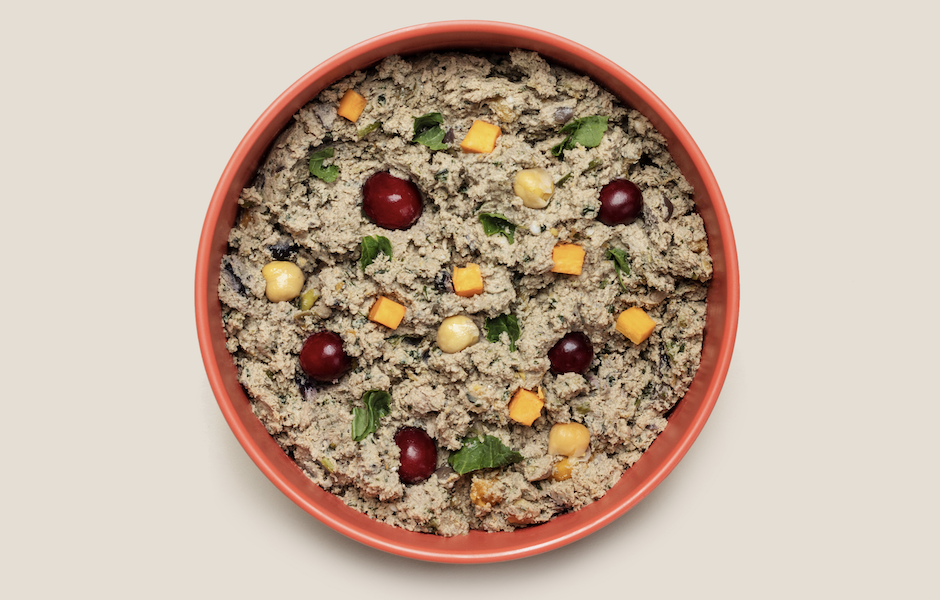

Find Out Which Recipe Plan is Right for Your Dog’s Needs
Get 50% of your first box of Ollie’s fresh
delivered meals today!
Homemade Dog Food vs. Fresh Dog Food Like Ollie
Cooking for your dog at home can feel rewarding, you know exactly what’s in the bowl, you control the ingredients, and you skip fillers you don’t trust. But homemade dog food takes time, planning, and a lot of guesswork to get right.
One of the biggest risks with homemade meals is accidentally leaving out key nutrients your dog needs to stay healthy. Unlike people, dogs can’t just “eat a little bit of everything” and be fine. They need precise levels of protein, fat, fiber, vitamins, and minerals in every bite, and getting that balance right at home can be tough without a vet’s help.
That’s where fresh dog food brands like Ollie come in. Ollie takes the guesswork out of feeding fresh. Every recipe is carefully crafted by veterinary nutritionists to meet AAFCO standards for complete and balanced meals. You still get the good stuff, human-grade meat and veggies, no fillers, no by-products, but you don’t have to spend hours meal prepping or worry about gaps in nutrition.
The best part? Ollie fresh dog food arrives portioned and ready to serve. Just open, scoop, and watch your pup wag for real food made just for them. No complicated recipes. No nutrient calculators. No mess in your kitchen. Just real, balanced meals, delivered right to your door.
If you love the idea of feeding your dog fresh, wholesome meals but don’t have the time (or nutrition degree) to make it yourself, Ollie makes it easy to give your dog the very best without the stress.
Try Ollie Fresh Dog Food Today!
The Ollie blog is devoted to helping pet parents lead healthier lives with their pups. If you want to learn more about our fresh, human-grade food, check out MyOllie.com.
Tagged As:

The nutrition your dog needs,
the food they want.

Enjoying our articles? Subscribe our Newsletters and get new articles directly to your inbox
You might also like
18 September 2025
6 MINS READ
Can Dogs Eat Flaxseed? Is Flaxseed Safe For Dogs?
Wondering if flaxseed is safe for your dog? This guide breaks down the benefits, risks, and best ways to add flaxseed, or flaxseed oil, to your pup’s diet.
18 September 2025
6 MINS READ
Why is My Dog Not Eating But Acting Normal? Causes & What To Do
Worried your dog isn’t eating but still acting normal? Here’s what could be going on and what to do to help your pup get their appetite back.
18 September 2025
5 MINS READ
Can Dogs Eat Crab? Is Crab Meat Safe For Dogs?
Thinking about giving your dog crab meat? Find out if it’s safe, what risks to watch for, and when crab might do more harm than good.
